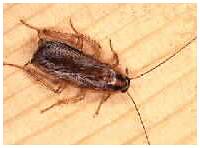German Cockroach
The German cockroach is the cockroach of concern, the species that gives all other cockroaches a bad name. It occurs in structures throughout Florida, and is the species that typically plagues multifamily dwellings.
The German cockroach is found throughout the world in association with humans and they just love the Florida climate since cold temperatures limits their survival. They are unable to survive in locations away from humans or human activity. The availability of water, food, and harborage also help the ability of German cockroaches to establish populations.
The German cockroach has three life stages typical of insects with incomplete metamorphosis: the egg, nymph, and adult. The entire life cycle is completed in about 100 days. However, factors such as temperature, nutritional status, and strain differences may influence the time required to complete a life cycle. German cockroaches breed continuously with many overlapping generations present at any one time. Under ideal conditions, population growth has been shown to be exponential. Actively growing field populations are comprised of 80 percent nymphs and 20 percent adults. The German cockroach is omnivorous, eating table scraps, pet food, and even book bindings.
German cockroaches adulterate food or food products with their feces and defensive secretions, physically transport and often harbor pathogenic organisms, may cause severe allergic responses, and in extremely heavy infestations have been reported to bite humans and feed on food residues on the faces of sleeping humans. In addition, some scientists suggest that German cockroach infestations may cause human psychological stress and that the stigma associated with infestations alters human behavior. For example, people with infested houses do less entertaining, and avoid the kitchen at night for fear of encountering a cockroach.
Since the German cockroach is considered an aesthetic pest, the action threshold for this insect depends upon the tolerance of the people living in the infested dwelling. However, most people associate cockroach infestations with poor sanitary conditions and typically go to excessive lengths to eradicate them from their houses.
American Cockroach
The American Cockroach is also commonly known as the Palmetto Bug. When cockroaches run over food they leave filth and may spread disease. They secrete an oily liquid that has an offensive and sickening odor that may ruin food. This odor may also be imparted to dishes that are apparently clean. Excrement in the form of pellets or an ink-like liquid also contributes to this nauseating odor. Some people are allergic to cockroaches and become ill.
The American Cockroach is a rural and suburban pest that mainly infests single-family, suburban houses and yards. It is abundant outdoors, where populations of 30,000 to 250,000 per acre have been found. The adults are strong fliers and readily enter the houses.
The American Cockroach is a strong flier. American Cockroaches will invade any opening in a house, such as a lighted doorway or window. Once inside, they will crawl on an illuminated television screen and on walls while the lights are on during the evening. Because the peak activity period of American Cockroaches coincides with our leisure time, the presence of the cockroach is obvious.
The feeding behavior of the American Cockroach appears to be similar to other cockroaches, in that they are omnivorous. Thus, they may be capable of carrying the same pathogenic organisms as the other peridomestic and domestic species of cockroaches. Considering their ability to produce large populations and their likelihood of entering homes, pathogens associated with animal droppings and soil microorganisms will be carried by this cockroach when it enters the home. People sensitive to allergens of German cockroaches are also sensitive to allergens of American Cockroaches.



